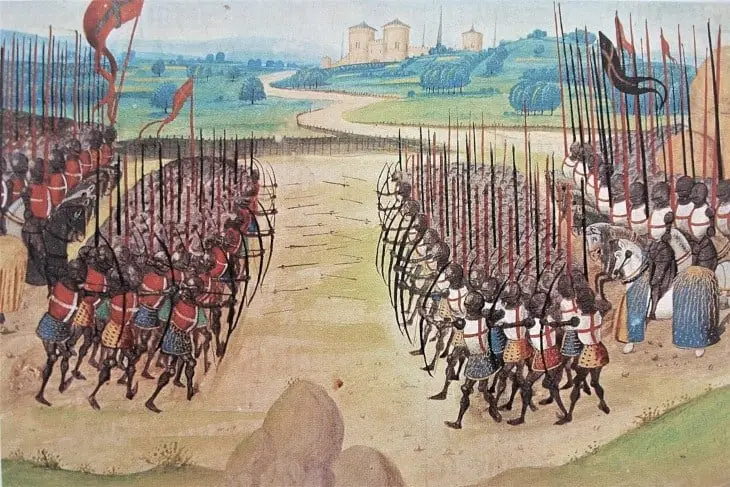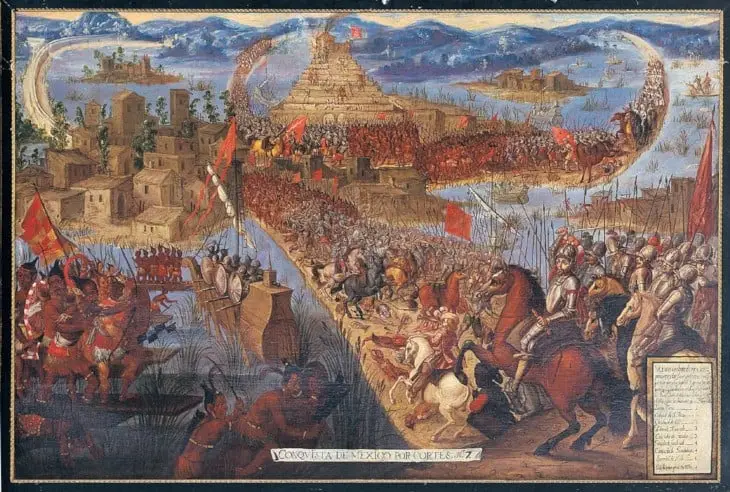The history or archery has seen many variations on the simple bow, from the relatively simple (the longbow), to the relatively complex (the crossbow).
Here, we’ll take a “deep dive” and compare these two bows: we’ll look at crossbows vs. longbows in the Medieval era, how these two weapons performed in battle—their strengths and weaknesses—and then we’ll talk about the modern experience of recreationally shooting both of these bows, and how they perform on a bowhunt.
If you’re a historian, an RPG enthusiast, or simply an archer who wants to learn more about your hobby, hopefully there’s something here for you.

Crossbows vs. Longbows in the Medieval Era
Both longbows and crossbows were important weapons during the Medieval Era, and each played an important role in military and civilian life. For the time period, they were advanced technology that ultimately determined Europe’s history and the fate of its kingdoms.
Crossbows: The Details
These are, perhaps, the more complicated of the two weapons, so we’ll start here:
Construction of Crossbows
At the beginning of the Medieval Period, craftsmen made crossbows almost entirely of wood—usually yew or olive wood, which was the same material used for the vertical bows of the time. By the end of the Medieval Period, construction was more complicated—steel laths, or limbs, were common, but these increased the draw weight of the weapon so much that a crank or windlass was necessary to cock it.
A typical crossbow was usually about two feet wide at the limbs and around 18 inches long (though this varied greatly between makers of crossbows). The bowstring was very thick and usually made of animal sinew, though hemp was popular too. The bolts were very light compared to longbow arrows, as little as 1.25 ounces and usually made of wood with a steel or iron head. They were also a bit shorter than arrows, as is the case today.
Crossbow Statistics
Crossbows had incredibly high draw weights, sometimes reaching over 500 pounds. Obviously this was impossible for anyone to draw, so it required cranks or multiple people (or both!). As a result, crossbows did not have a high rate of fire. Skilled crossbowmen could maybe make two or three shots a minute, with accuracy up to 400 yards. Medieval crossbows, even those with hundreds of pounds of draw weight, only shot bolts at around 140 feet per second, which is not much faster than the longbows of the time. Their strength, as it is today, was their incredible potential for accuracy, which far surpassed that of longbows. Longbows had other strengths, as we’ll explore in a minute, but that feature—ease of accuracy—is a crossbow’s main advantage.
Usage of Crossbows
The crossbow actually became popular before the longbow. While the crossbow was invented in China as early as 650 BC and quickly spread to ancient Europe, its use in both warfare and hunting seems to have died out by the 5th Century. There is little archaeological evidence of mass crossbow use again until the 10th Century when the French began using it as a siege weapon.
The French used crossbows during the famous Battle of Hastings in 1066, when William the Conqueror of Normandy (which is a pretty intimidating name, if you think about it) invaded England and defeated the Anglo-Saxon King Harold. This would forever change the politics, culture and language of England, something that would ultimately have global implications. In fact, legend has it that Harold was killed by an arrow, which may have come from a Norman crossbow.
Through the 12th Century, crossbows were a more popular weapon than longbows in all European armies except England’s. Since crossbows were more complicated and expensive to produce, crossbowmen held prestigious rank in the military and were usually paid well. A crossbow commander was one of the most important military roles in the Spanish, French and Italian armies. Crossbowmen required an entire support team to help with maintenance and cocking the powerful weapon.
Despite considerable competition from the longbow, crossbows remained in use in Europe until the end of the Medieval period and the popularization of firearms. Hernán Cortés, the Spanish conquistador, even used crossbows in his conquest of the Aztecs in Mexico in 1521. During this 500-year span, crossbows were an essential part of any arsenal, a powerful weapon that could penetrate almost any armor that had been developed. They were so powerful in fact that at one point the Catholic Church tried to ban them.
(Interested in crossbows? Click here to learn about the most common history crossbow—the recurve crossbow, and our picks for the best modern-day tools.)
Longbows: The Details
While simpler than crossbows, longbows have proved just as historically important, and we’ll start with:
Construction of Longbows
As the name suggests, Medieval English longbows were very long, usually over six feet and therefore longer than most of the men using them. The English and Welsh preferred yew wood but sometimes used ash and elm as well. A bowsmith had to dry a piece of wood for an entire year and then slowly work it into the classic D shape over the course of another year. Wax protected the wood and made it last.
The bow strings were made of hemp, flax, or silk. Military arrows were usually uniform, made of wood, over two feet long and tipped with a steel bodkin arrowpoint. Arrows for hunting were much more varied, and included numerous types of wood like beech and hazel, and came in many different lengths.
Longbow Statistics
Reaching arrow speeds of a bit over 130 FPS, Medieval longbows didn’t shoot much slower than the crossbows of the time. Meanwhile, they had much lower draw weights, somewhere around 70 pounds. This meant a Medieval archer could shoot over 12 arrows a minute.
They also had an absolute maximum range of about 400 yards, though the practical range was much less. Accurate shots over 300 yards were record-breaking shots by the best archers. The average archer was accurate somewhere closer to 200 yards, and Henry VIII—the guy who had six wives and beheaded two of them–made the practice range for conscripts at 220 yards.
Still, soldiers on the battlefield could not maintain accuracy at this distance for long. Their arms tired quickly, so combined with the fatigue of marching and fighting in general, only 10% of Medieval archers would be effective at a range of 200 yards after just a week of campaigning.
Usage of Longbows
Longbows have existed since the very beginning of human history as a hunting tool, but they were actually not popularized for European warfare until the mass use of the English longbow during the Hundred Years War, which was fought between the English and French from 1337 to 1453. Its success in battle ultimately led to a shift away from crossbows and towards longbows as a range weapon, at least until firearms were invented.
Compared to the crossbow, the English longbow was a much cheaper weapon to produce, and it was less complicated to maintain and operate. Furthermore, its lower draw weight meant archers could fire dozens of shots per minute while still penetrating thick Medieval armor.
Their main downside was the amount of training required to be accurate with the weapon. England only became successful with the longbow because they fomented an elaborate culture of archery that encouraged boys to start learning on the longbow from a young age. During the 13th Century, England even passed a lot that required men to attend weekly longbow training. This way, there was always a large pool of archers to conscript into the army.
All that hard work finally paid off in three major battles during the Hundred Years War: Sluys in 1340, Crécy in 1346 and Agincourt in 1415. Each was a marked English victory where longbows beat out the French’s slower crossbows.
In the Battle of Agincourt in particular, a confident, numerically superior French army of up to 25,000 was defeated by a tired English army of about 8,000, nearly 7,000 of which were archers armed with longbows. These longbowmen stood on the flanks of the infantry and cavalry where they were protected by the other soldiers as well as barriers like spikes. The heavily armored French cavalry repeatedly advanced on the English lines, but the expert longbowmen picked them off easily leading to over 6,000 French dead, mostly noble knights.
Although the English ultimately lost the Hundred Years’ War, their victories in these battles radically changed Medieval European warfare. Specifically, the French and their allies began moving away from crossbows as their primary range weapons and towards the longbow, the rapid fire of which could now apparently be used effectively against armored cavalry.
(Interested in longbows? Check out our post on the best modern longbows here).

Crossbows vs Longbows: Which Is Better for Battle?
The fact that both crossbows and longbows remained in use through the end of the Medieval Period until the popularization of firearms suggests that they both had their uses in battle. We do know that longbows became increasingly popular throughout the period, at least as a field weapon, but crossbows still had their uses.
Longbows were faster and more agile than crossbows while still capable of penetrating armor. Their downside was the high amount of expertise required to use them accurately. Kingdoms like England that used the longbow extensively had to throw a lot of effort behind training, and that meant money and a higher loss of investment when archers were killed in battle. In fact, the Hundred Years’ War destroyed Medieval England’s economy because so much had been invested in their war machine, archers being a major part of that.
Still, the English proved that longbows were the superior weapon for field combat—which is any battle where two armies met in an open field. Swordsmen and spearmen would clash on the front lines while archers provided cover fire. Longbows are better for this kind of fighting because they can fire faster—shooting over a dozen arrows per minute, a strong archery corps could take down advancing cavalry before they reached the lines, especially by targeting horses.
Crossbows, on the other hand, are arguably the better defensive weapon. Even while longbows spread through medieval England and France, crossbows still played a role defending castles. Here the speed of longbows was not as important as the distance of fire of crossbows. The cover of the castle walls meant that a crossbowman had plenty of time to cock his weapon and aim it perfectly. Indeed, Medieval sieges frequently lasted years, and once aimed, a crossbow archer could loose his bolt on an encamped army hundreds of yards away.
Crossbows are also the superior choice when it comes to revolutions, insurrections, and guerilla warfare. Although they’re more expensive and more difficult to make, this is outweighed by their ease of use. Crossbows don’t take the thousands of hours needed to become lethal that longbows do. As a result, Medieval peasant uprisings often relied on the crossbow, something civilians could quickly pick up.
Crossbows vs Longbows: Which Is Better for Modern-Day Bowhunting?
Surprisingly, much of the same aspects of crossbows and longbows that determined their roles in Medieval battles make a difference when it comes to going on a hunting trip in the 21st Century. Each is a powerful weapon capable of taking down even the largest game like moose and cape buffalo, just as they were capable of penetrating armor and chainmail six hundred years ago. Neither is absolutely better than the other, but depending on your personal situation and hunting goals, one might be the more ideal choice.
Just like it was in the Medieval period, the most important difference between crossbows and longbows is the required expertise. Most people can spend a few hours familiarizing themselves with a crossbow and be ready to hunt. Meanwhile, it’s neither practical nor ethical to hunt with a longbow without considerable hours of practice on the range. It’s much more difficult to shoot a longbow accurately because you have to hold the bowstring back yourself—that takes strength and stamina, and an untrained archer will eventually begin to waver. The crossbow does this work for you, and you can focus on aiming.
So what’s the implication? Longbows are more about the journey. It’s fun and rewarding to build up your skills and finally get your harvest. Crossbows, on the other hand, are about the destination. If you just want a successful hunt and don’t have the required time to build the necessary skills with a longbow, a crossbow is a much quicker way to get started.
Also, like their Medieval counterparts, modern crossbows have much higher draw weights and sometimes require cranks or drawing aids. For hunting, this usually means you only have one shot. There’s not enough time to reload before the animal escapes. A skilled longbow archer, however, could theoretically reload, draw, and fire again before an animal flees out of range.
Unlike Medieval crossbows, though, modern crossbows more efficiently take advantage of those high draw weights to produce blistering arrow speeds sometimes over 400 feet per second, with nearly 200 foot-pounds of kinetic energy. That’s fast and forceful, and again, it makes hunting a great deal easier—it makes the weapon more accurate because the bolts drop less quickly and can travel farther. Plus, a shot that’s slightly off may still be able to power through tendon or bone to harvest an animal. With a longbow, you’ll have to hit the perfect shot, and you’ll have to incorporate more factors, like wind and gravity—but success can be all the more rewarding because of it.
Finally, it’s important to take into account portability. Longbows are usually lighter than crossbows, and can be more comfortable for a still hunter (that is, hunters who slowly comb through the woods to encounter game). Survivalists who go on multi-day hunting trips really like longbows because they don’t weigh you down, and their simple design and use fits perfectly with the minimalist thrill. Crossbows, on the other hand, are good for hunting from a tree stand or tower—much like Medieval crossbows were great for shooting out of castle towers, modern crossbows can be better for ambush hunting from above, and you can rest them already cocked beside you in your tree stand and wait for your quarry to come to you.
Modern-Day Usage Differences and the Shooting Experience
In general terms, both crossbows and longbows take advantage of the same physical properties: drawing the string bends back the flexible limbs, which store energy much like a spring. When the string is released, the limbs fling the bowstring forward—along with anything attached to it, like a bolt or arrow. Still, despite using the same tech, they are each very different to shoot and operate.
Longbows take a lot more interaction with the bow itself. You draw the bowstring and then have to hold it back yourself. As the most basic bow design, there are no mechanisms or machines to ease the draw or decrease draw weight. You have to do everything yourself and hold back all the tension with your shoulder muscles. This can be made even more difficult by the bow’s size. A typical longbow is taller than the vast majority of archers, and holding the bow upright with one arm while drawing with the other is no simple task.
As a result, aiming a longbow involves a lot more than just pointing it where you want it to go. It also means keeping the bow steady under heavy tension and adjusting the draw based on how far you want the arrow to travel. Modern longbows aren’t much faster than their Medieval predecessors, and rarely top 200 feet per second. The arrows begin to drop soon after leaving the bow, and still hunters from the ground often have to shoot slightly above their target so that the arrow arcs and drops into the target. That takes a lot of practice.
Crossbows were, of course, invented before firearms, but shooting them is still very similar. The bolt rests within the barrel, so you don’t have to support it at all. More importantly, the latch and trigger mechanism hold back the bowstring, so you don’t have to. Instead, you just pull the trigger when you want to fire, and it releases the bolt.
Aiming a crossbow, then, is more of a practical exercise than an “instinctive” one as with vertical bows. In other words, it’s a lot easier. Modern crossbows often have scopes or iron sights, and even when they don’t, you can still look down the barrel to aim. They shoot fast enough, sometimes well over 400 FPS, that you can accurately aim them this way. Modern scopes usually have pins for different distances, and after you sight them in at the range, they should be consistently accurate.
In the end, your shooting experience with a modern crossbow or longbow probably won’t be too far off that of Medieval soldiers, hunters, and peasants. Longbows are simple weapons that require you to be “one with the bow.” Crossbows are powerful, technologically complex weapons that allow you to focus more on accuracy.
Final Thoughts / Comparing the Two
Both crossbows and longbows play an integral role throughout history, and while this post has spoken mostly of Western civilization, both have played a part in cultures all around the world. Hopefully something here has sparked your interest—if you’d like to learn more, please poke around the site. The world of archery is a fascinating place that connects you to people and places throughout time eternal!



